Today’s world is also known as the world of software with its builders known as Software Engineers. It’s on them that today we are interacting with each other because the webpage on which you are reading this blog, the web browser displaying this webpage, and the operating system to run the web browser are all made by a software engineer.
In today’s blog, we will start by introducing software engineering and will discuss its history, scope, and types. Then we will compare different types of software engineers on the basis of their demand in the industry. After that, we will discuss on full-stack developer job role and responsibilities and will also discuss key skills and the hiring process for a full-stack developer in detail.
Introduction
Software is a set of instructions, data, or programs used to operate a computer and execute specific tasks. In simpler terms, the software commands the hardware how to function. And, the study of the art of design, development, and maintenance of software is known as Software Engineering.
History
The term ‘Software Engineering’ dates back to the late 1950s and early 1960s. Margaret H. Hamilton was the person who came up with the idea of naming the discipline- Software Engineering. Its initial phase of rising was accompanied by the so-called software crisis of the 1960s, 1970s, and 1980s, which identified many of the problems of software development, such as cost and budget overruns, property damage, and even causing loss of life in some projects.
The rise of the Internet in the 1990s led to very rapid growth in the demand for Software Engineers. The growth of browser usage, running on the HyperText Markup Language (HTML), changed the way in which information display and retrieval were organized.
The beginning of the 21st century is no less than a miracle in the field of software engineering. The craze for software engineers is increasing exponentially in the industry and shows no sign of stopping. Even during the job crisis of the COVID-19 era, “Software Engineering” was considered one of the least risky professions in the world. This was possible because of the easier digitalization of the software industry.
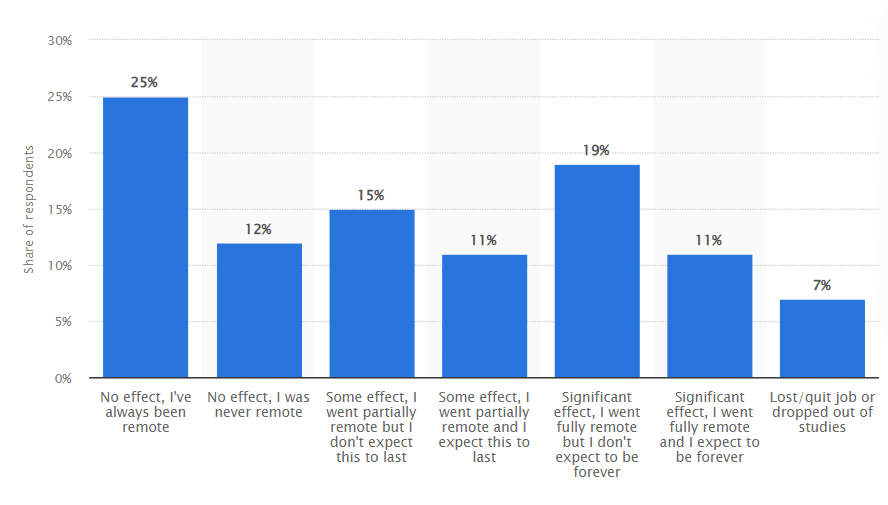
Scope
Software engineers are the most sought-after professionals on the market in 2022 with a global community of more than 26.9 million engineers. There were 1.3 million software engineer job vacancies available in 2021 in India alone, with 5.8 million developers employed at that time. This is due to the rapid growth of technology.
As the world is moving online, everyone, whether it is an individual or a business, wants to mark their presence digitally. This is mostly because of benefits such as flexibility, a large customer base, analytics report, and less-investment-more-profit provided by the digital market. Around 70-80% of people research a company online before visiting it or making a purchase. Therefore, it is no longer an option but has become necessary for businesses to be present digitally.
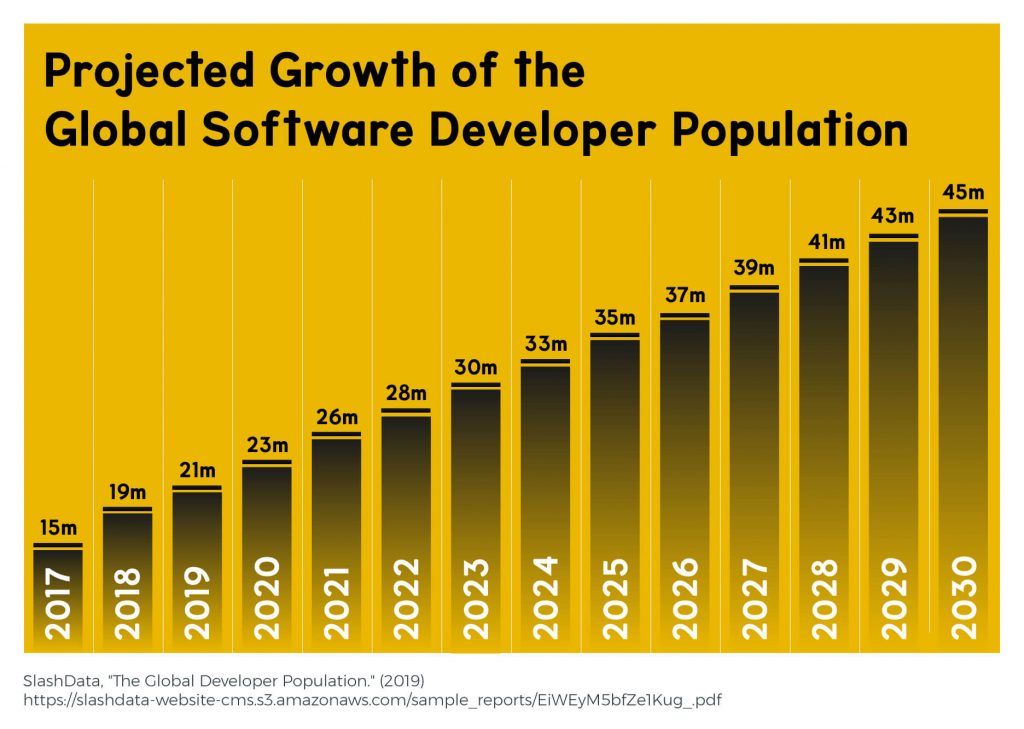
According to the Progressive Policy Institute (PPI), India will be the country with the largest software developer population in 2024 followed by the US.
According to the U.S. Bureau of Labor Statistics (BLS), the number of job opportunities in software development is projected to increase by 22% from 2020 to 2030, much higher than the projected national average growth rate for all professions of 8%.
By 2030, it is estimated that 45 million people worldwide will be working as software engineers. – That’s the total population of a country like Argentina.
So, if you are planning to make a career in software engineering, this is the right time to start. The best part about this profession is that you don’t need to be completely proficient before entering the industry, which is expected in other professions. The only expectation from you is to have a hunger for learning new things and a desire for problem-solving despite any odds.
Types of Software Engineers
There are many different types of software engineers, such as-
- A Front-End Developer who is responsible for designing the visual look or we can say the user interface of the website.
- A Back-End Developer who is responsible for the behind-the-scenes logic and infrastructure of the site.
- A Full-Stack Developer who is responsible for both the front end and back end of a web application.
- A Mobile App Developer who is responsible for developing mobile applications.
- A Game Developer who is responsible for the design and development of video games.
….. and many more.
The most in-demand among them is a web developer: Full Stack developer, Back-End developer, and Front-End developer.
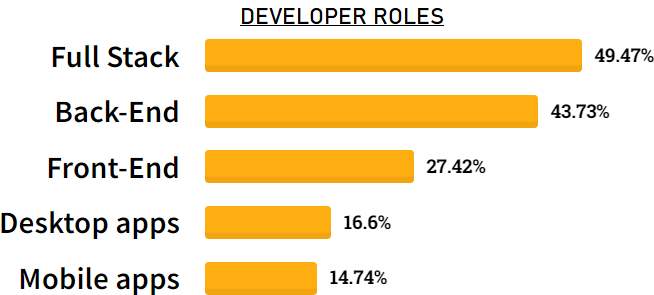
Web developers are more in demand than other developers due to the high demand for websites in comparison to desktop or mobile applications. Currently, there are around 2 billion websites in the world with a rate of three new websites being created every second. On the other hand, there are fewer than 10 million mobile apps and an even smaller number of desktop apps in the world currently. This huge gap itself tells us the reason for web developers being in greater demand than other developers.
Among the three types of web developers, full-stack developers are the most famous. It is also obvious because of their capability of handling both the front-end and back-end of a website and building end-to-end web applications. So, they are considered a complete package. Hence, instead of hiring front-end and back-end developers separately, companies prefer to hire full-stack developers.
Full-Stack Developer
As we have discussed above, a full-stack developer is a person who can handle both the front-end and back-end of a website. The term “full-stack” refers to the technologies and skills needed to complete a project, with each individual component being a ‘stack’. They are responsible for the entire process of developing a website from start to finish independently. They are skilled at dealing with all kinds of work such as databases, servers, system engineering, architecting, and client communication that are required to make complete products.
Higher salaries, flexibility, future growth, and continuous learning are some of the perks that come with this job.
Responsibilities
The responsibilities of a full-stack developer vary from company to company. Yet they need to fulfill some key responsibilities, which are-
- Developing front-end architecture of a website, which includes designing interactive, responsive, and dynamic web pages
- Developing back-end architecture of a website, providing high functionality and scalability to the website
- Troubleshooting, debugging, maintaining, and upgrading the software on a regular basis according to the market needs
- Transforming business needs into a finished product from conception to implementation
- Working with team members of different expertise to provide a user-friendly and smooth website application as an end-result
- Staying updated with emerging tools and technologies in the development world.
The hiring of a Full-Stack Developer
It’s not easy to become a full-stack developer. You may face several challenges in your day-to-day life. But that’s what improves your skills. That’s what helps you grow. That’s what brings the best out of you. After all, the role of a full-stack developer is all about overcoming challenges with minimal effort.
Everyone faces challenges in life. It’s a matter of how you learn to overcome them and use them to your advantage.
Celestine Chua
So, let’s discuss the hiring process for a full-stack developer. We will also discuss the skills required in accordance with each round of the process. You can go through the following webinar to get a better picture of the hiring process.
So, the hiring process usually consists of four rounds, which are-
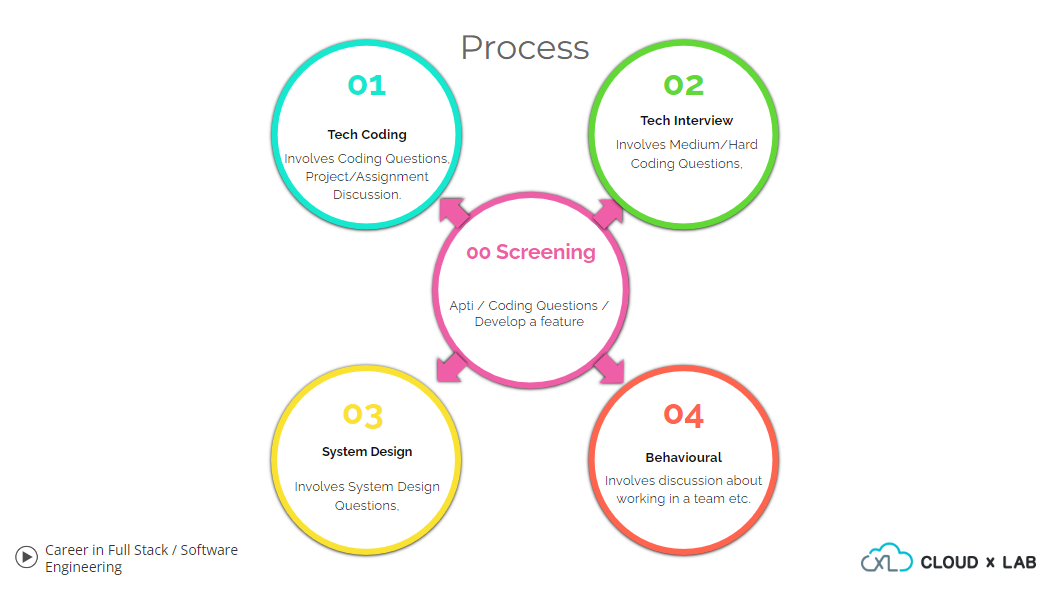
Coding Round
The coding round is the first round for which you may appear during the hiring process. There can be a variable number of coding rounds depending on the size and scale of the company. For example, tech giants like Facebook and Google usually conduct 4-5 coding rounds. The level of difficulty keeps on increasing with each round. This is done to filter the best out of the best candidates. On the other hand, startups or small-scale companies only conduct 1-2 coding rounds. The main objective behind this round is to test your ability to write code to solve problems and optimize your code further.
This round can be conducted in two ways:-
- Competitive Coding– It is conducted either on the company’s own platform or on a common platform such as HackerRank or CodeChef. Here, you are given some coding questions, which you have to solve in the pre-decided time period. The questions vary in their level of difficulty. There is no involvement of the interviewer here.
- Interview Coding– It is conducted during the interview. Here, the interviewer first asks you questions about your assignment or projects mentioned in your resume, and then gives you a series of questions (generally 2-3) and observes you while you write up the code. He observes your problem-solving approach, skills, fluency, and practice during the process.
Most companies initially conduct competitive coding round to filter out the good candidates and then conduct the interview coding round for the qualified candidates.
Skills
- Learn a programming Language
- Preferably Python – Faster to code
- Check CloudxLab Course
- Learn Data Structures & Algorithms
- Learn to calculate memory & time complexity
- Learn Lists, Dynamic Programming, Trees, graphs, etc.
Strategy
- Run down the test inputs and outputs
- Explain a very simple brute force approach
- Optimize your code
- Communicate – All the time
- Seek hints from the interviewer
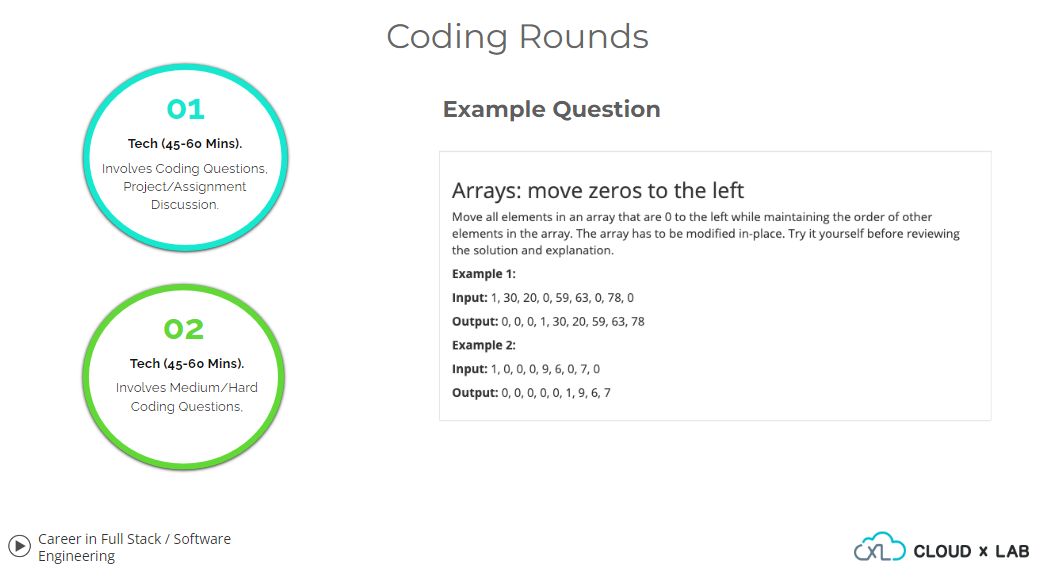
How to prepare – references?
- Book:
- Elements of Programming Interviews
- Cracking Coding Interviews
- Websites:
Note: This round is common for every Computer Science job role. Whether it be a full-stack developer, an app developer, or a Data Scientist, problem solving, DSA, and programming are the basic skills required in every CS job role.
System Design Round
The students who qualify in the coding round are given the opportunity to appear in the system design interview round. Now, this is where your full stack skills are tested.
Skills
- Web Architecture:- This includes basic knowledge of some common internet concepts, such as networking, protocols, servers, browser, etc.
- Front-end:- This includes tools and languages used to design the front-end of the website. The most common are-
- HTML, which is a scripting language for writing web pages
- CSS, which is a stylesheet language for styling the web pages
- JavaScript, which is a programming language for making the webpages interactive and dynamic
- Bootstrap, which is a CSS framework for making the work easier
- Back-end:- This includes tools and languages used to design the back-end of the website. This includes-
- Programming language, such as Python, PHP, Java, etc. for coding the backend,
- Backend Framework, such as Django, NodeJS, etc. for rapid development of secure and maintainable websites,
- Hosting platforms, such as AWS, Azure, Google Cloud, etc. to build, deploy, and manage websites,
- Database management tools, such as MYSQL, PostgreSQL, etc for working with databases,
- Containers, such as Docker, Kubernetes, etc. to package applications into containers for delivering software quickly,
- CI/CD tools, such as Jenkins or Travis for automating the stages of website development,
- APIs, such as REST-API, SOAP, etc. for communication between applications,
- Caching systems, such as Memcache, Redis, etc.
- Version Control Systems such as GitHub, Gitlab, AWS code commit, etc for tracking and managing changes to software code.
Don't worry! You don't have to learn them all. You can choose any one from each stack according to the demand in the industry.
Strategy
- Ask questions to get clarity
- Understand the end objective
- Functional Requirement
- # of users per month, concurrent
- Storage requirement, TPS
- Constraints
- Discuss a design for small scale (Not Optimal)
- Scale the design
- Discuss Trade-Offs
How To Prepare
- Learn the skills mentioned above and practice them as much as you can.
Behavioral Round
At last, comes the behavioral round. It is a non-technical round conducted by an Engineering Manager or HR. The main objective here is to understand if you really are culturally fit.
You are assessed in various areas such as:
- Intrinsic motivations
- Empathy
- Ability to be proactive
- Perseverance works past obstacles
- Able to work in an unstructured environment
- Conflict resolution – How you deal with conflict and disagreements with colleagues and managers.
- Growth
- Communication skills
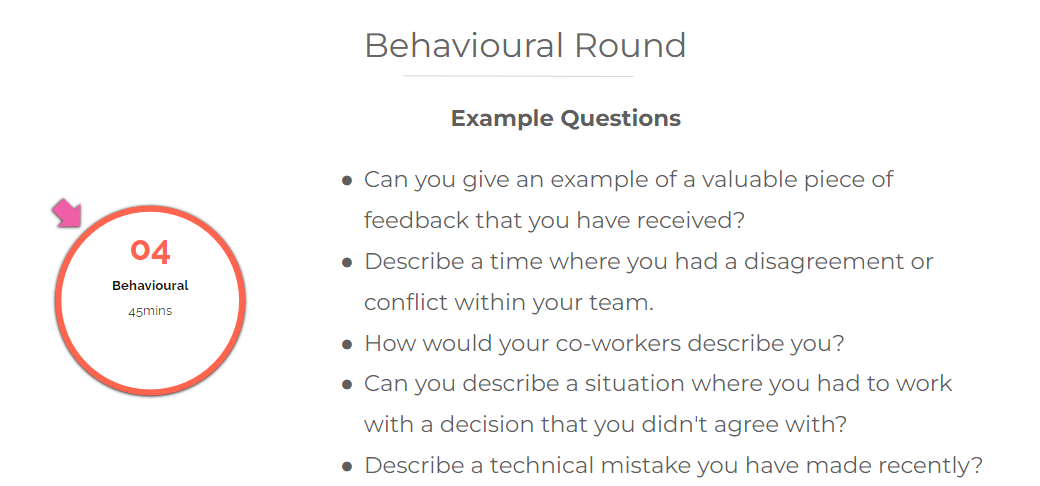
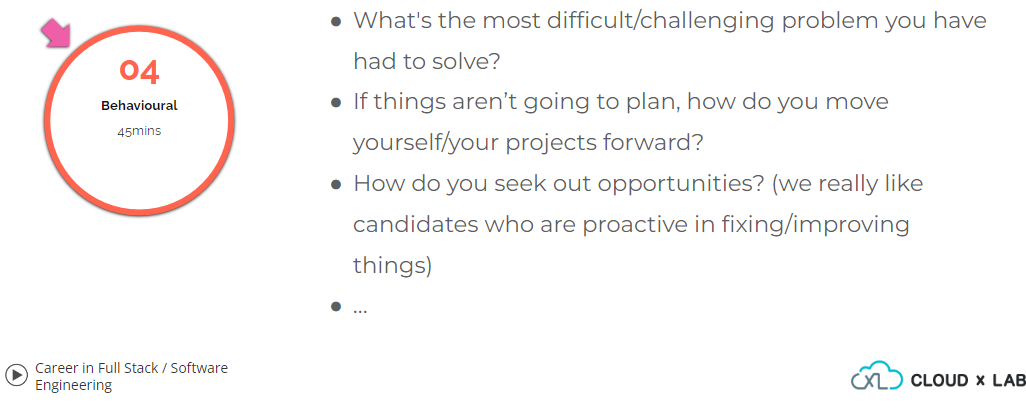
Strategy
- Stay calm and be honest
- Before the interview starts, always practice smiling.
How to Prepare
- During preparation, write down the answers to the most commonly asked questions in details
- Ask a friend to ask you any questions. Do multiple mock interviews.
To be able to successfully execute a software project, you must have great communication and management skills. In the current time of remote and diverse teams, communication has become the most important ingredient of a successful career. Being good at communication opens your doors to next steps in your careers such as Software Development Manager, Product Management, Program Management, etc. Therefore, it is most essential to intertwine the technology and communication sessions.
On clearing this round, you get an offer letter from the company and that’s the first time you realize that all that hard work paid off.
Helping Hand
As I have said before, it’s quite difficult to become a full-stack developer on your own as you have to gather random pieces of scattered information from the internet and combine them on your own to learn all these skills. For a newbie, it becomes even more difficult as it’s a vast field with an endless stream of knowledge. So, it becomes hard to figure out how much to grasp. This results in:
- Waste of time in gaining useless information,
- Moving aside from the right learning path developing uncertainty,
- Sometimes, never reaches the destination (i.e. Full Stack Developer).
Also, that may not seem like a problem at the start of the journey, but later on, this is the thing that forces people to leave the journey mid-way. After all, it’s a long journey! But as you know- No journey is too long with the right company. And with the right guidance, the path becomes a lot easier. So the thing you need is- Guidance.
Therefore, it’s advised to take a course or join a program that may provide you proper guidance. You can check our Full Stack Development regarding it.
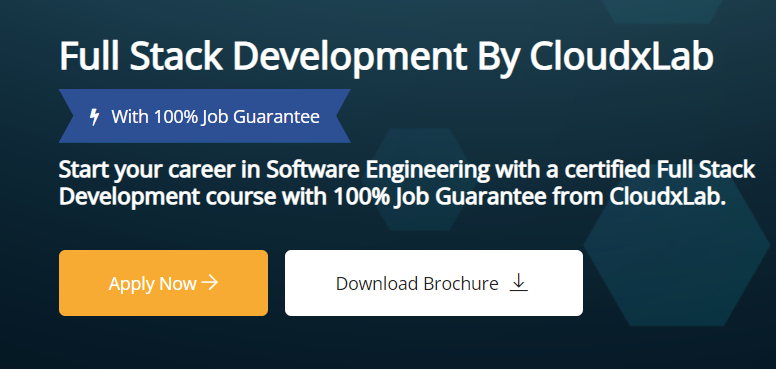
Conclusion
So that’s all for today. In this article, we have done a detailed analysis of Software Engineering. By now, I am sure that you have sufficient information to decide whether to choose this industry or not. Happy Learning!!
